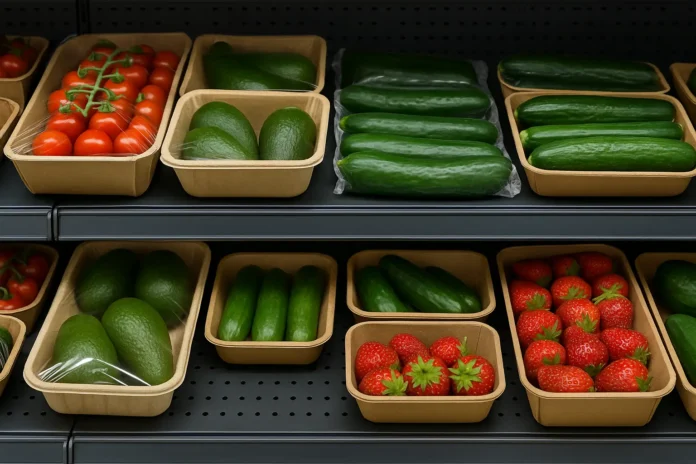Supermarkets have spent the past decade promising to cut plastic. Now, more than ever, they’re under pressure to show it’s not just greenwashing. From seaweed-based films to mushroom trays and smart compostable wraps, the next generation of biodegradable packaging is becoming real — but not without hurdles.
This deep dive looks at what’s working in stores today, what still costs too much, and what retailers say they need next to make plastic truly redundant on shelf.
Seaweed and Algae: Beyond the Straw
Notpla is one of the UK’s best-known startups tackling single-use plastic with seaweed. Its edible bubble sachets turned heads at the London Marathon a few years back, but the focus has moved to sturdy takeaway boxes and trays.
A 500-pack of Notpla’s seaweed-lined burger boxes costs around £125 — about 23–25p each. For comparison, a basic styrofoam burger box is still as low as 7p, and a standard paper box is roughly 31p. So seaweed sits comfortably between foam and quality paper, with the bonus of being naturally biodegradable in weeks.
Retailers like Just Eat and a handful of UK cafes have tested Notpla’s packaging at scale. But supermarkets still hesitate — not because the concept isn’t proven, but because national scale contracts demand production volumes that seaweed startups aren’t yet set up to deliver consistently.
Mushrooms on the Shelf — Literally
Mushroom-based packaging is gaining ground in protective packaging for electronics, but fresh food is trickier. US supplier Ecovative produces mycelium trays that grow into shape inside moulds — creating compostable protective packaging that can replace polystyrene and rigid foam.
While big brands like IKEA and Dell use Ecovative’s protective packaging in shipping, supermarket trials remain limited. Fresh produce buyers say hygiene standards and moisture control must match plastic, which means more lab work before mycelium can cradle your strawberries or cucumbers on a Tesco shelf.
Edible Cups and Newcomers
Edible packaging isn’t new — think ice cream cones. But researchers keep pushing the boundaries. A recent highlight is IIT Roorkee’s edible kodo millet cups, which can hold liquids, resist leaks and break down naturally if binned.
Practical hurdles remain: short shelf life and the need for cold-chain storage for some edible materials limit immediate supermarket adoption. Still, brands chasing ‘zero waste’ snack ranges are keeping an eye on edible formats for desserts and novelty seasonal offers.
Smart Biodegradable Films
Smart packaging is usually about RFID or QR codes. The latest twist combines biodegradable wraps with spoilage sensors — thin NFC chips that detect gas changes when produce turns. A UK research team published promising prototypes last year, showing wraps that biodegrade after weeks while helping supermarkets cut food waste and re-stocking costs.
These smart films aren’t yet in Aldi or Lidl, but pilots are running with suppliers in the Netherlands and Canada. Early signs show savings on shrink (wasted produce) could outweigh the extra pence per pack.
Compostable Plastics: The Scaling Dilemma
Polymateria is a name to watch. Its so-called ‘biotransformation’ tech embeds a masterbatch in traditional plastic film. If lost in the environment, it breaks down into natural wax and CO₂ within a year, leaving no microplastics.
Tests in the UK, verified by the University of Oxford, show real-world breakdown without industrial composters — a big sticking point for many bioplastics.
Unit cost? Still about 20–30% higher than basic LDPE film, but brands see value in the ‘real biodegradability’ claim, which passes recent EU anti-greenwashing rules.
What Retailers Are Actually Using
Aldi UK has made some of the biggest practical swaps:
Switched porridge oats to paper packs, saving 57 tonnes of plastic a year.
Introduced paper wine bottles (94% recycled content), cutting 39 tonnes of CO₂ in transport.
Removed glass and metal from soap pump heads — less fancy, but 200 tonnes of packaging saved each year.
Rolled out sugarcane pulp trays for ready meals, saving 67 tonnes of plastic and 52 tonnes of cardboard annually.
Sainsbury’s replaced plastic trays for chicken and fish with cardboard, saving 694 tonnes a year. Their avocado shelf trials swap hard plastic for paper wraps, which could eliminate over 20 million plastic pieces annually if rolled out chain-wide.
Pitfalls: Where ‘Biodegradable’ Fails
Not every ‘compostable’ pack lives up to the label. Many bioplastics require industrial composting at high heat — and if tossed in household waste, they often end up incinerated or landfilled. UK recycling infrastructure is still patchy, and shoppers rarely separate biowaste properly.
Retailers say a true fix needs clear labelling, public education, and local councils to step up food waste collection — otherwise, even the cleverest plant-based wrap ends up burned like old clingfilm.
Real Costs at a Glance
| Material | Estimated Cost/Unit | Compostable? | In Use? |
|---|---|---|---|
| Seaweed burger box (Notpla) | ~23–25p | Yes (home) | Limited UK trials (foodservice) |
| Paper burger box | ~31p | Yes (home) | Widely used |
| Foam burger box | ~7p | No | Still used in some takeaways |
| Sugarcane tray | ~20–35p (varies) | Yes (home) | Common in ready meals |
| Mushroom protective tray | Custom pricing | Yes (home) | In shipping, not yet food |
| Polymateria bioplastic film | +20–30% vs LDPE film | Yes (nature) | Pilot in UK, India |
Where Do Supermarkets Go Next?
Retail packaging leads at big chains now focus on three things:
Certainty: Will it break down at home, in backyard compost — not just in an industrial site 200 miles away?
Consistency: Can suppliers deliver enough volume, with zero defects, for millions of SKUs?
Communication: Can they tell shoppers exactly what to do with it — or risk backlash when new packs end up in landfill anyway?
The UK’s new Extended Producer Responsibility (EPR) rules — rolling out over 2025–2026 — mean retailers face packaging fees from £215 to £485 per tonne if they don’t hit recycling and reuse targets. That’s turning sustainability from a nice-to-have into a bottom-line cost item.
Final Word
Biodegradable packaging is no longer niche or just PR. Real tonnes of plastic are being cut each year — but price gaps, supply chain volume and consumer confusion still hold back full shelf-wide adoption.
Retailers willing to test bold new materials, pair them with honest shopper messaging, and push councils for better waste streams will come out ahead — financially and reputationally.
Quick Takeaway for GSN Readers
If you supply or buy packaging for supermarkets:
Watch seaweed and sugarcane as near-term practical swaps.
Follow biotransformation plastics for films that degrade without needing new bin systems.
Push for clear labelling so shoppers don’t ruin the system by mistake.



